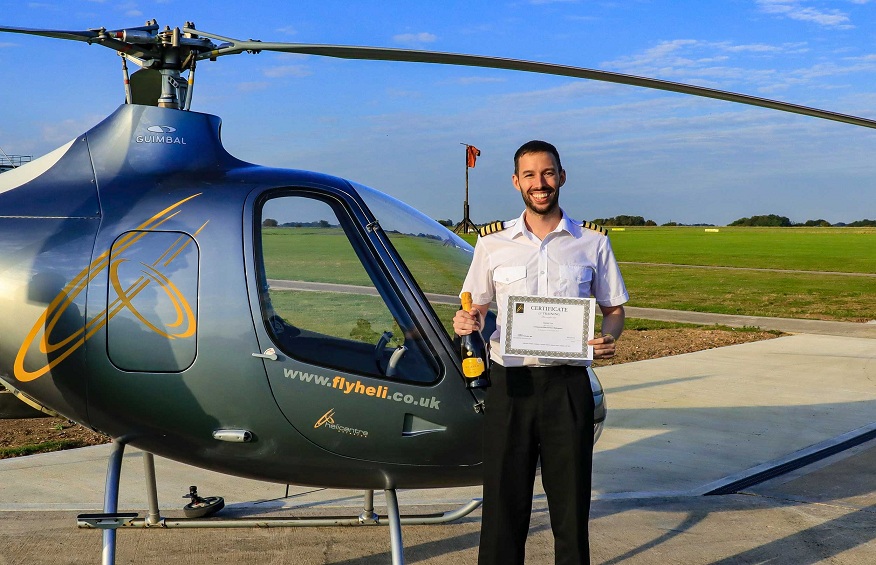Key Take a ways:
- Understanding the physics of flight is crucial in helicopter training, including concepts such as lift and translational lift.
- Mastering helicopter controls, including the cyclic, collective, and pedals, is fundamental for flight.
- Developing spatial awareness and situational analysis is important for safe helicopter operations.
- Considering different training options, researching accredited flight schools, and exploring financial assistance are essential when choosing a helicopter training program.
- Essential skills for helicopter pilots include precision and coordination, decision-making and problem-solving abilities, and effective communication and leadership skills.
- The helicopter training process involves ground school and flight lessons, with a varied duration and specific requirements.
- Preparing for ground school and flight lessons by familiarizing yourself with aviation knowledge and adhering to safety procedures is important.
- Staying motivated, setting clear goals, and persevering through challenges are key to success in helicopter training.
1. The Basics of Helicopter Training
Helicopter training is an exhilarating journey that allows individuals to commandeer these versatile aircraft and explore the skies. However, before embarking on this adventure, it is essential to understand the basics of helicopter training.
Understanding the Physics of Flight
One of the first things aspiring helicopter pilots must grasp is the physics of flight. Unlike fixed-wing aircraft, helicopters rely on the principles of lift, thrust, drag, and weight to stay airborne. Understanding how the rotor blades generate lift and control the helicopter’s movement is crucial.
During helicopter training, students will learn about the Bernoulli’s principle, which explains how air moves faster over the curved upper surface of the rotor blades, creating lower pressure and generating lift. They will also delve into the concept of translational lift, which occurs when the helicopter gains forward speed and encounters cleaner, more undisturbed air.
Mastering Helicopter Controls
Mastering helicopter controls is a fundamental aspect of training. Unlike an airplane, a helicopter has several complex controls that the pilot must manipulate simultaneously to achieve flight. These controls include the cyclic, collective, and pedals.
The cyclic control, located between the pilot’s legs, determines the helicopter’s direction of travel by tilting the rotor disc. Pushing the cyclic forward pitches the helicopter downward, while pulling it backward pitches the nose up. Moving the cyclic to the left or right causes the helicopter to bank in that direction.
The collective control, usually located to the pilot’s left, adjusts the pitch angle of all the rotor blades simultaneously. By raising or lowering the collective, the pilot can increase or decrease lift, respectively.
The pedals, located at the pilot’s feet, control the helicopter’s yaw or rotation about its vertical axis. Pressing the left pedal causes the helicopter to yaw to the left, while pressing the right pedal causes it to yaw to the right.
During training, students will spend hours honing their coordination skills to manipulate these controls smoothly and instinctively.
Developing Spatial Awareness and Situational Analysis
Developing spatial awareness and situational analysis is another crucial aspect of helicopter training. As a helicopter pilot, it is essential to have a keen understanding of your surroundings and be able to quickly analyze and adapt to changing conditions.
During training, pilots-in-training will learn to navigate through various weather conditions and terrain. They will practice techniques such as scanning the cockpit instruments, maintaining situational awareness, and observing outside references to assess their position relative to the ground.
Additionally, helicopter pilots must have the ability to react swiftly to emergencies and make split-second decisions. They will learn hazard identification and risk management techniques to ensure safe flight operations.
2. Choosing the Right Helicopter Training Program
Choosing the right helicopter training program is a crucial step towards achieving your dream of becoming a helicopter pilot. With numerous options available, it is essential to consider various factors before making a decision.
Exploring Different Training Options
When exploring helicopter training options, there are several routes you can take. One option is to train at a dedicated flight school that specializes in helicopter training. These schools often have experienced instructors and comprehensive training programs tailored specifically for helicopter pilots.
Another option is to join a university or college aviation program that offers helicopter training. These programs may provide a more structured academic approach to aviation and could lead to a degree in aviation or a related field.
Before making a decision, it is essential to research and compare the different training options available to find the one that aligns with your goals, preferences, and budget.
Researching Accredited Flight Schools
Researching accredited flight schools is a crucial step in choosing the right helicopter training program. Accreditation ensures that the school meets specific standards set by aviation authorities, ensuring high-quality training and safety standards.
When researching flight schools, it is important to consider factors such as the school’s reputation, the qualifications and experience of the instructors, the condition and maintenance of the training aircraft, and the success rate of previous students. Reading reviews and speaking with current or former students can provide valuable insights into the training program’s quality.
Considering Financial Assistance and Scholarships
Helicopter training can be a significant financial investment. However, there are various financial assistance options and scholarships available to help alleviate the financial burden.
Before committing to a training program, it is essential to research and explore financial assistance options such as student loans, grants, and scholarships. Many aviation organizations and foundations offer scholarships specifically for aspiring helicopter pilots. Applying for these scholarships can significantly reduce the cost of training.
Additionally, some flight schools offer financing options or partnerships with financial institutions to help students finance their training.
3. Essential Skills for Helicopter Pilots
Being a helicopter pilot requires a combination of technical skills, decision-making abilities, and effective communication. Here are some essential skills that aspiring helicopter pilots must develop during their training.
Developing Precision and Coordination
Precision and coordination are crucial skills for helicopter pilots. The ability to operate the controls with finesse and accuracy is essential for smooth and controlled flight.
During training, students will practice precise hover maneuvers, landing on confined areas, and flying in close proximity to obstacles. These exercises help develop the necessary precision and coordination skills needed for safe and efficient helicopter operations.
Building Decision-Making and Problem-Solving Abilities
Helicopter pilots often encounter challenging situations that require quick decision-making and problem-solving skills. During training, pilots-in-training will be exposed to various scenarios and taught how to assess risks, evaluate options, and make informed decisions.
Simulator training is an integral part of developing decision-making and problem-solving abilities. Simulators allow pilots to experience different emergency situations and practice responding to them in a controlled environment.
Enhancing Communicative and Leadership Skills
Effective communication and leadership skills are crucial for helicopter pilots, especially in situations involving multiple crew members or passengers.
During training, pilots will learn effective communication techniques, including radio procedures, precise and concise verbal commands, and teamwork. They will also develop leadership skills, learning how to oversee a flight operation and make critical decisions while maintaining effective communication with crew members and air traffic control.
4. Navigating the Helicopter Training Process
Understanding the Training Timeline and Requirements
The helicopter training process can vary in duration and requirements depending on the chosen training program and the individual’s dedication and progress.
Typically, helicopter training consists of both ground school and flight lessons. Ground school covers theoretical knowledge such as aviation regulations, meteorology, navigation, and aerodynamics. Flight lessons provide hands-on experience in operating the helicopter and applying the knowledge gained in ground school.
The duration of training can range from a few months to a year or more, depending on the intensity of the training and the availability of flight instructors and aircraft.
Additionally, acquiring a private pilot license for helicopters requires meeting specific requirements set by aviation authorities, including a minimum number of flight hours, passing written and practical exams, and demonstrating proficiency in various flight maneuvers.
Preparing for Ground School and Flight Lessons
Preparing for ground school and flight lessons is essential to make the most of your helicopter training. Prior to starting training, it is beneficial to familiarize yourself with aviation terminology, basic aerodynamics, and navigation principles.
Creating a study plan and obtaining study materials such as textbooks, online courses, or study guides can help you prepare for ground school. Familiarizing yourself with the theoretical knowledge beforehand can save time during the training process and help you grasp the concepts more effectively.
Before starting flight lessons, it is important to understand and adhere to the safety procedures and regulations outlined by the flight school. Pre-flight preparation, including inspecting the aircraft and reviewing the flight plan, is crucial for safe flight operations.
Overcoming Challenges and Staying Motivated
Helicopter training can be challenging and demanding, both physically and mentally. It is important to stay motivated and overcome obstacles along the way.
Setting clear goals and maintaining a positive mindset can help you stay focused and committed to your training. Surrounding yourself with supportive peers and mentors can provide encouragement and guidance when faced with challenges.
Remember that perseverance and dedication are key to success in helicopter training. Stay motivated, embrace the learning process, and never lose sight of your passion for flying.
FAQ
Question: What is the difference between lift and translational lift?
Answer: Lift is the force generated by the rotor blades of a helicopter, allowing it to stay airborne. Translational lift occurs when the helicopter gains forward speed and encounters cleaner, more undisturbed air, resulting in increased lift.
Question: What are the main controls of a helicopter?
Answer: The main controls of a helicopter are the cyclic, collective, and pedals. The cyclic control determines the helicopter’s direction of travel, the collective control adjusts the pitch angle of all the rotor blades, and the pedals control the helicopter’s yaw or rotation about its vertical axis.
Question: What skills do helicopter pilots need?
Answer: Helicopter pilots need precision and coordination skills to operate the controls with finesse, decision-making and problem-solving abilities to assess risks and make informed decisions, and effective communication and leadership skills for multi-crew or passenger situations.
Question: How long does helicopter training typically last?
Answer: The duration of helicopter training can vary but typically ranges from a few months to a year or more, depending on the intensity of the training and availability of flight instructors and aircraft.
Question: What are the requirements for acquiring a private pilot license for helicopters?
Answer: The requirements for acquiring a private pilot license for helicopters include meeting a minimum number of flight hours, passing written and practical exams, and demonstrating proficiency in various flight maneuvers.
Question: How can I prepare for helicopter ground school and flight lessons?
Answer: To prepare for helicopter ground school and flight lessons, it is beneficial to familiarize yourself with aviation terminology, basic aerodynamics, and navigation principles. Creating a study plan, obtaining study materials, and understanding and adhering to safety procedures are also important.
Question: What should I do to stay motivated during helicopter training?
Answer: To stay motivated during helicopter training, it is important to set clear goals, maintain a positive mindset, surround yourself with supportive peers and mentors, and embrace the learning process. Perseverance and dedication are key to success.
Question: Are there financial assistance options available for helicopter training?
Answer: Yes, there are various financial assistance options available for helicopter training, including student loans, grants, and scholarships specifically for aspiring helicopter pilots. Some flight schools may also offer financing options or partnerships with financial institutions.
Useful Resources:
- Aircraft Owners and Pilots Association (AOPA)
- Federal Aviation Administration (FAA)
- National Business Aviation Association (NBAA)
- Helicopters Magazine
- Vertical Magazine
- Helicopter Page
- HeliHub
- com




